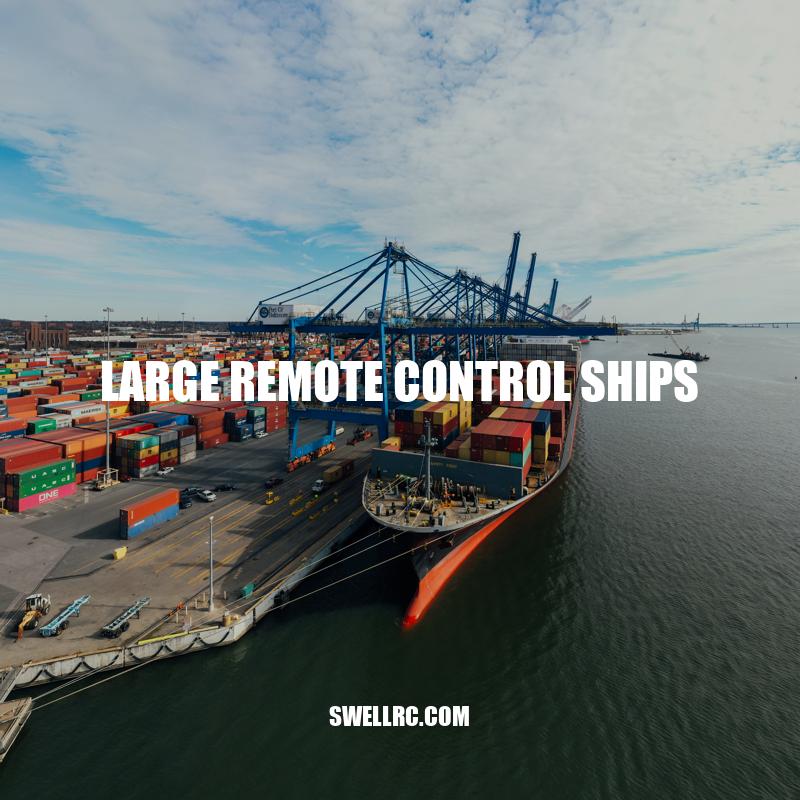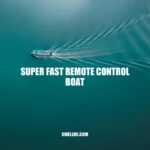Exploring the Capabilities and Applications of Large Remote Control Ships
Large remote control ships are becoming an increasingly popular option for various applications, such as cargo transport, scientific research, and military operations. These ships, also known as unmanned surface vessels (USVs), are equipped with advanced navigation and control systems that allow for remote operation from a control centre or aboard a manned vessel. The use of large remote control ships offers several benefits, including improved safety by reducing the need for humans to be onboard, increased efficiency in freight transport, and the ability to collect valuable data and insights in scientific research. Although there are still challenges and limitations to overcome, continued advancements in technology are making these ships an attractive option for a wide range of applications.
Large remote control ships have evolved over decades of technological advancements. From the days of simple and rudimentary remote controls, the design and capabilities of these vessels have undergone significant improvements. Here is a brief history of the development of remote control technology:
- Early uses of remote control technology date back to the late 19th century with the invention of the remote-control torpedo by Nikola Tesla in 1898.
- In 1917, the US Navy developed the first remote control (RC) aircraft for military use.
- During World War II, remote control technology was further developed and used in various applications, such as explosive ordnance disposal and target drones.
- By the late 20th century, advances in computer and navigation technology enabled more sophisticated remote control systems for use in maritime operations.
Large remote control ships have now become a reality thanks to these technological advancements. Several websites offer information and resources for individuals and organizations interested in these vessels, such as Maritime Robotics, L3Harris, and SeaRobotics.
When were remote controlled boats invented?
Remote controlled boats were invented in 1898.
Current applications of large remote control ships
Large remote control ships have found a wide range of applications across various industries. Here are some of the most common uses:
- Commercial Shipping: Large remote control ships are used for cargo transport and offshore services. They are generally smaller in size, and are used for tasks such as surveying, towing, and oil rig servicing.
- Military: Military organizations use large remote control ships for surveillance and reconnaissance purposes. These vessels are equipped with advanced sensors, radars and cameras, enabling the detection of potential threats from a distance.
- Scientific Research: More recently, larger remotely controlled vessels have been developed for scientific research and exploration purposes. Examples include oceanic mapping and oceanography, deep sea exploration, and monitoring of ocean life and sea pollution.
Along with their practical applications, large remote control ships have also set some interesting records such as:
| Record | Ship Name | Date of Record |
|---|---|---|
| Fastest unmanned vessel | Proteus | 2019 |
| Longest offshore autonomous mission | AMOS | 2018 |
| Deepest remotely operated underwater vehicle dive | MBARI | 2019 |
Several companies offer large remote control ships for sale or lease. Some of the companies include Sea Machines Robotics, L3Harris, and MARINTEK.
What is a remote control boat?
A remote control boat is a miniature watercraft that is controlled by a remote device. It can be powered by electric, gas or steam engines. These boats are popular for hobbyists and enthusiasts who enjoy racing or exploring bodies of water. Some popular remote control boat brands include Traxxas and Pro Boat. Websites such as Amazon and HobbyKing offer a variety of remote control boats for purchase.
Features and capabilities of large remote control ships
Large remote control ships are designed with advanced features and capabilities that enable efficient and safe operation. Here are some of the key features:
- Navigation and control systems: These ships are equipped with sophisticated navigation systems that enable precise control and movement. The control systems include joysticks, displays, and computer interfaces that allow the operator to control various functions such as speed, direction, and maneuvering.
- Artificial intelligence and machine learning: AI and machine learning are increasingly being used in large remote control ships to improve performance and automate certain tasks. For instance, they can optimize fuel consumption, monitor the ship’s surroundings for obstacles or other vessels, or even predict mechanical failures before they happen.
- Environmental sensors: These types of sensors detect, measure, and monitor various environmental parameters such as water temperature, salinity, current, and wave height, which are essential for safe and efficient operation
- Power systems: These ships use different types of power systems from diesel engines to electric motors, which can be controlled and equipped with features that optimize performance and minimize fuel consumption.
The advancements in remote control technology has resulted in the development of autonomous “self-driving ships” designed to operate without human interaction. The benefits of these ships include improved safety, cost efficiency, and optimized performance. An example of an autonomous ship is the “Yara Birkeland,” which is an all-electric container ship that operates autonomously and will reduce emissions by replacing conventional diesel-powered vessels.
What do you need for a RC boat?
You will need a boat kit, a two or more channel radio system, an electric motor, a speed control, running hardware including shaft and propeller, a battery, and a charger for the battery to make an RC boat functional. You can find these items on various retail websites such as Amazon or HobbyKing.
Challenges and limitations of large remote control ships
Large remote control ships come with their set of challenges despite their increasing popularity. Here are some of the challenges and limitations:
- High cost: Building and maintaining remote control ships can be expensive due to the advanced technology and equipment required for operation.
- Range and endurance: The range and endurance of remote control ships are limited compared to traditional ships. A remote control ship must be in the line-of-sight of the operator, while other factors such as battery capacity and weather can have an effect.
- Dependence on technology and human oversight: Remote control ships rely on advanced technology that can malfunction or fail. Additionally, oversight and control must be conducted by humans to prevent accidents and ensure safety
- Regulations: The development of remote-controlled ships is subject to regulation by national and international maritime regulatory organizations. Obtaining necessary permits is an additional layer of cost and complexity for developers.
Furthermore, the rise of autonomous technology can result in job losses in the maritime industry. However, the shift towards autonomous shipping is still in its early stages, and the actual impact remains uncertain.
What are the challenges of autonomous ships?
Autonomous ships bring numerous benefits including increased efficiency, reduced costs and improved safety. However, there are several challenges to their implementation. One of the biggest challenges is the absence of crew, which raises issues of emergency response and monitoring. Another concern is compliance with navigation rules, as autonomous ships will need to interact with manned vessels and follow established protocols. In addition, there are concerns about seaworthiness and the possibility of human error in navigation, which could lead to accidents. Cyber risks are also a concern as autonomous ships will rely heavily on technology, making them vulnerable to hacking and other cyber threats. Finally, issues of liability and its limitation are complex and will need to be addressed before autonomous shipping can become a reality.
For more information on the challenges of autonomous ships, visit websites such as Maritime Executive or read publications like “The Future of Maritime Autonomous Surface Ships” by the International Maritime Organization.
Future developments and trends in large remote control ships
As technology continues to advance, there are several trends and future developments in large remote control ships to keep an eye on:
- Autonomous technology: Developers are exploring the use of autonomous systems to enable unmanned operations. With increased autonomy, remote control ships can operate more efficiently reducing costs and improving safety.
- Increased use in environmental monitoring and disaster relief efforts: Remote control ships can perform critical functions in environmental monitoring and disaster relief efforts; for instance, detecting oil spills, monitoring wildlife, and water quality.
- Improvements in efficiency and energy optimization: Developments in technology can help to optimize the energy used by remote control ships and make them more fuel-efficient. Increased fuel efficiency would significantly reduce costs and increase the range of remote control ships.
- Innovative propulsion methods: Developers are exploring new propulsion methods such as electric and hydrogen fuel cells, which will lead to more sustainable and environment-friendly solutions.
Overall, remote control ships’ future looks optimistic and leads to ecological, economical, and social benefits.
What are the future technologies in the shipping industry?
The future technologies in the shipping industry include autonomous vessels, blockchain technology for supply chain management, and advanced analytics for predictive maintenance. There are also developments in alternative fuels such as hydrogen and biofuels for shipping. For more information on the latest trends in the shipping industry, websites such as maritime-executive.com and worldmaritimenews.com offer up-to-date news and analysis on the latest technological advancements.
Conclusion
Large remote control ships are revolutionizing shipping and maritime operations, enabling safer and more efficient operations. While they present a few challenges and limitations, such as high costs and limited range, their benefits outweigh the challenges.
As technology continues to advance, we are likely to see remote control ships play a more significant role in commercial shipping, military and scientific research. The industry is continuously striving to develop and enhance their features and capabilities to optimize their efficiency and performance.
In conclusion, remote control ships are a significant development in the maritime industry, incorporating advanced technology that can improve transportation, surveillance, environmental monitoring, and disaster relief efforts. Remote control ships’ ability has revolutionized the industry and made maritime operations easier, safer, and cost-effective. As innovation in artificial intelligence and autonomous technology increases, remote control ships will lead to new possibilities, and the applications of this concept will continue to expand.



